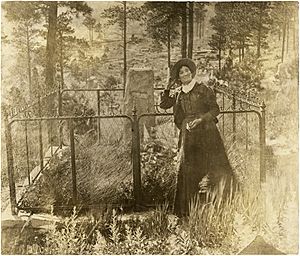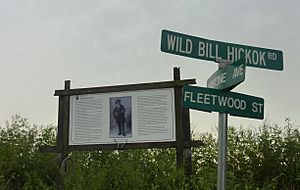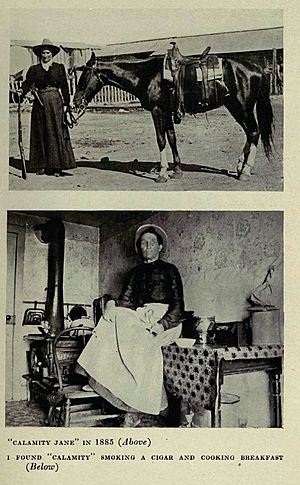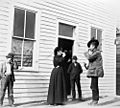Calamity Jane facts for kids
Quick facts for kids
Martha Jane Cannary
|
|
|---|---|

Calamity Jane, c. 1880
|
|
| Born |
Martha Jane Cannary
May 1, 1852 Princeton, Missouri, U.S.
|
| Died | August 1, 1903 (aged 51) Terry, South Dakota, U.S.
|
| Nationality | United States |
| Occupation | Explorer, Army scout, pioneer, storyteller, sharpshooter, performer, dance-hall girl |
| Spouse(s) | Clinton Burke William P Steers |
| Children | 2 |
| Parent(s) | Robert and Charlotte Cannary |
| Relatives | Five siblings |
Martha Jane Cannary (May 1, 1852 – August 1, 1903), better known as Calamity Jane, was a well-known American frontierswoman, sharpshooter, and raconteur. In addition to many exploits she was known for being an acquaintance of Wild Bill Hickok. Late in her life, she appeared in Buffalo Bill's Wild West show and at the 1901 Pan-American Exposition. She is said to have exhibited compassion to others, especially to the sick and needy. This facet of her character contrasted with her daredevil ways and helped to make her a noted frontier figure. She was also known for her habit of wearing men's attire.
Contents
Early life
Much of the information about the early years of Calamity Jane's life comes from an autobiographical booklet that she dictated in 1896, written for publicity purposes. It was intended to help attract audiences to a tour she was about to begin, in which she appeared in dime museums around the United States. Some of the information in the pamphlet is exaggerated or even completely inaccurate.
Calamity Jane was born on May 1, 1852, as Martha Jane Canary (or Cannary) in Princeton, within Mercer County, Missouri. Her parents were listed in the 1860 census as living about 7 miles (11 km) northeast of Princeton in Ravanna. Her father Robert Wilson Cannary had a gambling problem, and little is known about her mother Charlotte M. Cannary. Jane was the eldest of six children, with two brothers and three sisters.
In 1865, the family moved by wagon train from Missouri to Virginia City, Montana. In 1866, Charlotte died of pneumonia along the way, in Blackfoot, Montana. After arriving in Virginia City in the spring of 1866, Robert took his six children on to Salt Lake City, Utah. They arrived in the summer, and Robert supposedly started farming on 40 acres (16 ha) of land. The family had been in Salt Lake City for only a year when he died in 1867. At age 14, Martha Jane took charge of her five younger siblings, loaded up their wagon once more, and took the family to Fort Bridger, Wyoming Territory, where they arrived in May 1868. From there, they traveled on the Union Pacific Railroad to Piedmont, Wyoming.
In Piedmont, Jane took whatever jobs she could find to provide for her large family. She worked as a dishwasher, cook, waitress, nurse, and ox team driver. Finally, in 1874, she claimed she found work as a scout at Fort Russell.
Acquiring the nickname
Jane was involved in several campaigns in the long-running military conflicts with Native Americans. Her claim was that:
It was during this campaign [in 1872–73] that I was christened Calamity Jane. It was on Goose Creek, Wyoming where the town of Sheridan is now located. Capt. Egan was in command of the Post. We were ordered out to quell an uprising of the Indians, and were out for several days, had numerous skirmishes during which six of the soldiers were killed and several severely wounded. When on returning to the Post we were ambushed about a mile and a half from our destination. When fired upon, Capt. Egan was shot. I was riding in advance and on hearing the firing turned in my saddle and saw the Captain reeling in his saddle as though about to fall. I turned my horse and galloped back with all haste to his side and got there in time to catch him as he was falling. I lifted him onto my horse in front of me and succeeded in getting him safely to the Fort. Capt. Egan, on recovering, laughingly said: "I name you Calamity Jane, the heroine of the plains." I have borne that name up to the present time.
"Captain Jack" Crawford served under Generals Wesley Merritt and George Crook. According to the Montana Anaconda Standard of April 19, 1904, he stated that Calamity Jane "never saw service in any capacity under either General Crook or General Miles. She [...] never was in an Indian fight. She was simply a notorious character, dissolute and devilish, but possessed a generous streak which made her popular."
A popular belief is that she instead acquired it as a result of her warnings to men that to offend her was to "court calamity". It is possible that "Jane" was not part of her name until the nickname was coined for her. It is certain, however, that she was known by that nickname by 1876, because the arrival of the Hickok wagon train was reported in Deadwood's newspaper, the Black Hills Pioneer, on July 15, 1876, with the headline: "Calamity Jane has arrived!"
Another account in her autobiographical pamphlet is that her detachment was ordered to the Big Horn River under General Crook in 1875. She swam the Platte River and travelled 90 miles (140 km) at top speed while wet and cold in order to deliver important dispatches. She became ill afterwards and spent a few weeks recuperating. She then rode to Fort Laramie in Wyoming and joined a wagon train headed north in July 1876. The second part of her story is verified. She was at Fort Laramie in July 1876, and she did join a wagon train that included Wild Bill Hickok. That was where she first met Hickok, contrary to her later claims, and that was how she happened to come to Deadwood, where she settled.
After the death of Wild Bill Hickok
Following Hickok's death, Jane continued living in the Deadwood area for some time, and at one point she helped save numerous passengers in an overland stagecoach by diverting several Plains Indians who were in pursuit of the vehicle. Stagecoach driver John Slaughter was killed during the pursuit, and Jane took over the reins and drove the stage on to its destination at Deadwood.
In late 1876 or 1878, Jane nursed the victims of a smallpox epidemic in the Deadwood area.
Final years

In 1881, Jane bought a ranch west of Miles City, Montana, along the Yellowstone River, where she kept an inn. According to one version of her life, she later married Clinton Burke from Texas and moved to Boulder, where she once again made an attempt in the inn business.
In 1893, Calamity Jane started to appear in Buffalo Bill's Wild West show as a storyteller. She also participated in the 1901 Pan-American Exposition.
Death
In late July, Jane traveled by ore train to Terry, South Dakota, a small mining village near Deadwood. It was reported that while on board the train she had fallen ill. The conductor, S. G. Tillett, carried her off the train, a bartender secured a room for her at the Calloway Hotel, and a physician was summoned. Jane's condition deteriorated quickly, and she died at the hotel on Saturday, August 1, 1903, from inflammation of the bowels and pneumonia.
Calamity Jane was buried at Mount Moriah Cemetery, South Dakota, next to Bill Hickok.
Images for kids
See also
 In Spanish: Calamity Jane para niños
In Spanish: Calamity Jane para niños




